Related Research Articles
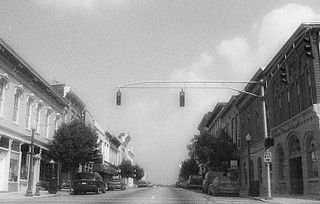
Shelbyville is a home rule-class city in and the county seat of Shelby County, Kentucky, United States. The population was 14,045 at the 2010 census.
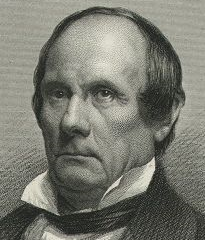
James Guthrie was a Kentucky lawyer, plantation owner, railroad president and Democratic Party politician. He served as the 21st United States Secretary of the Treasury under President Franklin Pierce, and then became president of the Louisville and Nashville Railroad. After serving, part-time, in both houses of the Kentucky legislature as well as Louisville's City Council before the American Civil War, Guthrie became one of Kentucky's United States Senators in 1865. Although Guthrie strongly opposed Kentucky's secession from the United States and attended the Peace Conference of 1861, and sided with the Union during the Civil War, he declined President Abraham Lincoln's offer to become the Secretary of War. As one of Kentucky's Senators after the war, Guthrie supported President Andrew Johnson and opposed Congressional Reconstruction.

The Louisville and Nashville Railroad, commonly called the L&N, was a Class I railroad that operated freight and passenger services in the southeast United States.

The geology of the Ohio River, with but a single series of rapids halfway in its length from the confluence of the Monongahela and Allegheny rivers to its union with the Mississippi, made it inevitable that a town would grow on the site. Louisville, Kentucky was chartered in the late 18th century. From its early days on the frontier, it quickly grew to be a major trading and distribution center in the mid 19th century, important industrial city in the early 20th, declined in the mid 20th century, before revitalizing in the late 20th century as a culturally-focused mid-sized American city.

The Union Station of Louisville, Kentucky is a historic railroad station that serves as offices for the Transit Authority of River City (TARC), as it has since mid-April 1980 after receiving a year-long restoration costing approximately $2 million. It was one of at least five union stations in Kentucky, amongst others located in Lexington, Covington, Paducah and Owensboro. It was one of three stations serving Louisville, the others being Central Station and Southern Railway Station. It superseded previous, smaller, railroad depots located in Louisville, most notably one located at Tenth and Maple in 1868-1869, and another L&N station built in 1858. The station was formally opened on September 7, 1891 by the Louisville and Nashville Railroad. There was a claim made at the time that it was the largest railroad station in the Southern United States, covering forty acres. The other major station in Louisville was Central Station, serving the Baltimore and Ohio, the Illinois Central and other railroads.
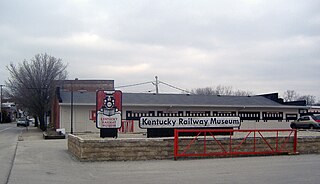
The Kentucky Railway Museum, now located in New Haven, Kentucky, United States, is a non-profit railroad museum dedicated to educating the public regarding the history and heritage of Kentucky's railroads and the people who built them. Originally created in 1954 in Louisville, Kentucky, the museum is at its third location, in extreme southern Nelson County. It is one of the oldest railroad stations in the United States.
Cherokee Gardens is a residential area six miles east of downtown Louisville, Kentucky USA. The area is a collection of small, unconnected subdivisions along Lexington Road and large estates built just outside Cherokee Park.

Louisville in the American Civil War was a major stronghold of Union forces, which kept Kentucky firmly in the Union. It was the center of planning, supplies, recruiting and transportation for numerous campaigns, especially in the Western Theater. By the end of the war, Louisville had not been attacked once, although skirmishes and battles, including the battles of Perryville and Corydon, took place nearby.
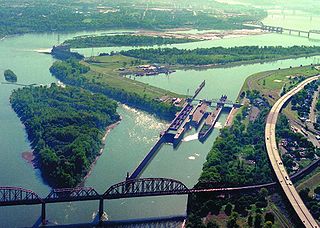
The Louisville and Portland Canal was a 2-mile (3.2 km) canal bypassing the Falls of the Ohio River at Louisville, Kentucky. The Falls form the only barrier to navigation between the origin of the Ohio at Pittsburgh and the port of New Orleans on the Gulf of Mexico; circumventing them was long a goal for Pennsylvanian and Cincinnatian merchants. The canal opened in 1830 as the private Louisville and Portland Canal Company but was gradually bought out during the 19th century by the federal government, which had invested heavily in its construction, maintenance, and improvement.
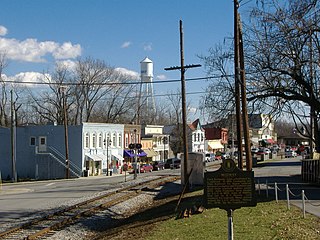
The Midway Historic District of Midway, Kentucky, was designated by the National Register of Historic Places as a historic district on November 17, 1978. In 2003, faced with a declining downtown, a major streetscape renovation project began as part of the Kentucky Main Street Program.
The Lexington and Ohio Railroad was the first railroad in the U.S. Commonwealth of Kentucky. Its charter proposed the establishment of a link between Lexington in the center of the Bluegrass Region to the river port of Louisville at the Falls of the Ohio by way of Frankfort, the state capital. The line was never completed and the Panic of 1837 led to its complete collapse. The Commonwealth seized the railroad in payment of its debts in 1840.

Louisville & Nashville No. 152 is a 4-6-2 "Pacific" type steam locomotive listed on the National Register of Historic Places, currently at the Kentucky Railway Museum at New Haven, Kentucky, in southernmost Nelson County, Kentucky. It is the oldest known remaining 4-6-2 Pacific to exist. It is also the "Official State Locomotive of Kentucky", designated as such on March 6, 2000.
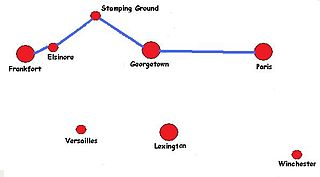
The Frankfort and Cincinnati Railroad is a defunct shortline railroad based in Kentucky. Despite its name, it had no connections with Cincinnati, Ohio.
The following is a timeline of the history of Lexington, Kentucky, United States.
The Louisville, Cincinnati and Lexington Railroad was a 19th-century railway company in the U.S. state of Kentucky. It operated from 1869, when it was created from the merger of the Louisville and Frankfort and Lexington and Frankfort railroads, until 1877, when it failed and was reincorporated as the Louisville, Cincinnati and Lexington Railway. It later made up part of the Louisville and Nashville network and its former rights-of-way currently form parts of the class-I CSX Transportation system.
The Shelby Railroad was a 19th-century railway company in the U.S. state of Kentucky. It operated from 1851, when it was created in Shelby County, until 1902, when it was purchased by the Louisville and Nashville Railroad network. Its former rights-of-way currently form parts of the class-I CSX Transportation system. As of 1 October, 2003, the Shelby, aka, the Old Road, has been leased and operated by R J Corman.
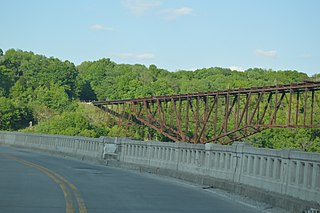
The Louisville Southern Railroad was a 19th-century railway company in the U.S. state of Kentucky. It operated from 1884 until 1894, when it was incorporated into the Southern Railway in Kentucky.
The Louisville, Harrods Creek and Westport Railway was a 19th-century railway company in the U.S. state of Kentucky. Its first president was James Callahan. It was organized by Louisvillian businessmen in 1870, began construction and operation of the 3 ft narrow gauge railway in 1872, and failed in 1879 owing to the era's Long Depression. The line then gave up hope of connecting to Westport or beyond and reincorporated as the more modest Louisville, Harrods Creek and Westport Railroad, which simply continued service along the existing track.
John Jeremiah Jacob was an American businessman, financier, real estate developer, and philanthropist active in Kentucky. He was involved in banking, as well as in commerce, real estate, and infrastructure: railroads, canal, bridge, and utilities.